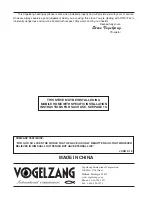
Page 18 / TR007 PONDEROSA™
Vogelzang International Corp.
VGZ-031 / 20120619.1
SERVICE HINTS
removed using a chimney brush or other commonly
available materials from your local hardware retailer.
Chimney fires burn very hot. If the unit or chimney
connector should glow red, reduce the fire by closing the
inlet air control and immediately call the fire department.
CAUTION: A CHIMNEY FIRE MAY CAUSE IGNI-
TION OF WALL STUDS OR RAFTERS WHICH
WERE ASSUMED TO BE A SAFE DISTANCE
FROM THE CHIMNEY. IF A CHIMNEY FIRE
HAS OCCURRED, HAVE YOUR CHIMNEY IN-
SPECTED BY A QUALIFIED EXPERT BEFORE
USING AGAIN.
A fire in the firebox may be smothered by pouring
a large quantity of coarse salt, baking soda, or cool
ashes on top of the fire.
PREVENTING CREOSOTE BUILDUP
1. Creosote will inevitably form in your chimney and
connector pipe. Following these steps will help
reduce the rate of build up.
2.
BURN ONLY SEASONED WOOD that has dried
for at least one year. (<20% humidity by weight)
3. Burn hardwood rather than softwood. Hardwood
is denser or heavier wood and burns hotter.
4. Do not attempt to burn (or mix in) green or wet
wood. The use of green or wet wood will cause a
rapid build up of creosote. Wood that hisses, sizzles
and blackens without igniting in five minutes must
be considered too wet to burn.
5. Do not attempt to extend the burn time by using
wet wood. Not only does burning wet wood rapidly
build up creosote, but it reduces the heat output by
up to 25 percent.
6. Burn the stove with the primary air inlet control
wide open (pushed in) for 10-25 minutes every
time fresh wood is loaded into the stove. Do not
load more than ¼ to ½ of the fuel capacity at one
time. Loading too much wood at once will cause
excessive smoke which contains creosote. Mature
fires or coals produce very little creosote-producing
smoke.
7. Burn with the primary air control open (pushed in)
for several minutes at numerous intervals through-
out the day, being careful not to over fire the unit.
Following this process will help to warm the chim-
ney and reduce the amount of creosote forming
condensation within the chimney.
8. Establish a routine for the handling of fuel, firing,
and operating the stove. Check daily for creosote
build up until experience shows how often you need
to clean for safe operation. Be aware that the hotter
the fire, the less creosote is deposited and weekly
cleanings may be necessary in mild weather even
though monthly cleanings may be enough in the
colder months.
WARNING: IN CASE OF CHIMNEY FIRE:
(1) CLOSE ALL AIR INLET CONTROL(S)
(2) GET OUT OF THE HOUSE
(3) CALL THE FIRE DEPARTMENT.
CHIMNEY DRAFT
The chimney is critical to the proper operation of
the stove.
It is the chimney that creates draft; THE
STOVE DOES NOT AND CANNOT CREATE DRAFT.
The chimney provides two vital functions for proper
stove operation. First, it is the passage to exhaust
smoke and hot gases created in the combustion pro-
cess. Secondly, it supplies the draft (or pressure) to
bring oxygen to the fire to sustain combustion. Draft is
the natural movement of air or gases through a chimney.
Chimney draft comes from the natural tendency for
hot (less dense) air to rise. As the hot air rises within
the chimney it creates a lower pressure at the bottom
of the chimney to which the stove is connected. The
higher pressure air outside the stove then rushes into
the stove where the lower air pressure level exists, thus
bringing oxygen to the fire. This constant flow of air is
referred to as the draft. Many factors or combination
of factors can act together to build or impede the draft.
Without the correct amount of draft, the stove will not
operate properly.
If there is excessive draft, an unsafe condition will
arise with too much air being drawn into the stove and
creating an excessively hot fire. This could cause over
firing which runs the risk of igniting structural elements
around the stove and chimney.
The most common experience is that of insufficient
draft. Under insufficient draft conditions, the fire will be
starved for oxygen, improper or incomplete combustion
occurs resulting in smoke spillage into the area around
the stove. A fire that is starved for oxygen will not burn
well. Such a fire will produce excessive smoke that will
cool and condense in the chimney creating creosote.
Excessive amounts of creosote buildup can ignite
causing a chimney fire with the possibility of structural
elements igniting as well.
Correct any draft related issues before using the
stove. The following are some possible causes of
insufficient draft. Please note that one or more factors
may play a role in a draft issue and certain factors may
change over time as conditions vary.
OPERATING continued . . .
continued on next page









































